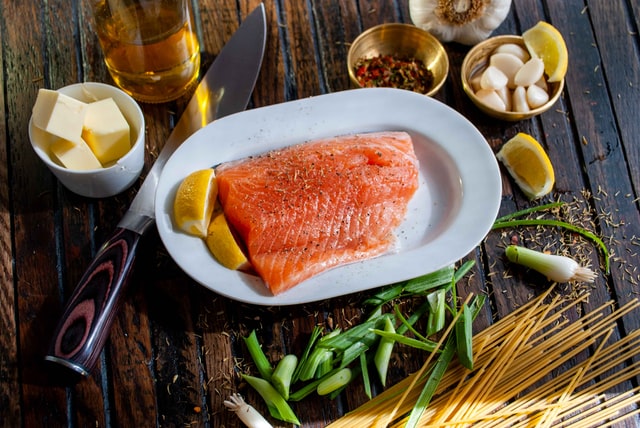Do you like your salmon caught in the wild or raised on a farm? It’s a good question because fish isn’t “just fish” when it comes to the health benefits it might have. It makes a difference where it comes from.
We asked Julia Zumpano, RD, who is a registered dietitian, how wild salmon and farmed salmon compare in terms of their nutritional value. Let’s fish for some facts with her.
What kinds of salmon there are
Salmon is the most popular fish in the United States. This is mostly because it is high in omega-3 fatty acids, which are good for your heart. Overall, fish is a great source of omega-3 fatty acids, and salmon is at the top of the list.
The number of wild salmon in open water has dropped, though, because salmon is so popular. As a result, farmed salmon is becoming more common because people want it more than the high tide.
Most farm-raised salmon is Atlantic salmon. When salmon is caught in the wild, it is usually one of five types: chinook (king), sockeye, coho, pink, or chum. (The most common kind is sockeye.)
Zumpano says that it is true that both Atlantic and Pacific salmon are full of omega-3 fatty acids. But if you dig deeper into the nutrition facts, you’ll find that there’s a lot more to think about when you’re at the seafood counter.
Here’s a better look at it.
Nutritional content
GoodData Central, which is part of the U.S. Department of Agriculture, says that there are some important differences in how wild and farmed salmon are fed. (Wild sockeye salmon and farmed Atlantic salmon cooked in dry heat are compared.)
The same amount of wild salmon (3 ounces) has fewer calories and half as much fat as farmed salmon. Even though farmed salmon might have more omega-3 fatty acids, it has more than twice as much saturated fat, which is not the kind of fat you want, says Zumpano.
In the end, wild salmon is better because it has less saturated fat and fewer calories.
Risky pollutants
POPs, which stand for “persistent organic pollutants,” sound like they could be bad. Because they are.
Several diseases, like Type 2 diabetes and obesity, have been linked to POPs. There are signs that having POPs in your body could make obesity an even bigger risk factor for diabetes. And some types of POPs make women more likely to have a stroke.
What’s the point? Because the amount of PCB, which is one type of POP, in farmed fish is 16 times higher than in wild fish.
In the end, wild salmon is the clear winner here.
Chemicals that cause cancer
This is a hard question to answer in the wild vs. farmed debate. Even though both have omega-3 fatty acids, if you ate a lot of either type of fish to get the most out of them, you could be exposed to chemicals that cause cancer.
In wild salmon, these chemicals come from the water where the fish swim, which could be polluted. The PCB levels in farmed salmon are higher because of what they are fed.
The best thing to do is not eat too much fish. Zumpano says that when it comes to getting omega-3 fatty acids, seafood is just one piece of the puzzle. Flaxseed, chia seeds, hemp seeds, walnuts, and soy foods are also good sources.
In the end, eating a lot of either wild or farmed salmon can be dangerous. But most studies show that wild salmon is safer when eaten in moderation.
Unsafe contaminants
Studies have shown that farmed salmon tend to have more contaminants than wild salmon.
Contaminants are below the levels allowed by the U.S. Food and Drug Administration (FDA), but they are above what the U.S. Environmental Protection Agency (EPA) says is safe “for frequent consumption.”
Also, other research suggests that children, women of childbearing age, and women who are pregnant should choose wild salmon over farmed salmon or other sources of omega-3 fatty acids.
Zumpano says that the skin should be taken off of both wild and farmed salmon to reduce the number of contaminants and pollutants that the fish is exposed to.
In the end, both wild and farmed salmon have harmful chemicals in them, but wild salmon has less of them and is thought to be safer overall.
Worry over antibiotics
When Chilean salmon was sent to Japan in the late 1990s and early 2000s, it had more antibiotics than the law allowed. This was a big point of debate.
The worry is that too much use of antibiotics could make people less sensitive to their effects. People say that antibiotic use in farmed fish has gone down, but it’s not clear how much use is still going on.
The bottom line is that antibiotic use is unknown with farmed salmon. Wild salmon does not.
So, what are you having for dinner?
The American Heart Association says that eating two 3.5-ounce servings of fish a week can help lower the risk of heart disease and stroke. Both farmed salmon and wild salmon have the nutrients that support this idea.
But research shows over and over again that farmed salmon are more dangerous than salmon caught in oceans, lakes, and rivers.
Bottom line: If you have the chance, try something different, and if you need a recipe, here are five to try.
